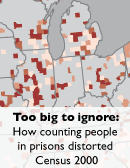
Too big to ignore:
How counting people in prisons distorted Census 2000
By Rose Heyer and Peter Wagner
Prison Policy Initiative
April 2004
Section:
Conclusion
The statistical impact of counting incarcerated people as prison-town residents, rather than residents of their places of origin, is largest in prison hosting communities because the incarcerated population tends to be a large portion of the community. It is often possible for a knowledgeable researcher — at great effort — to adjust the data to remove the incarcerated population and make the data match the prison community’s conception of itself.
Although the magnitude of the impact is smaller in the prisoner-exporting communities, Census data is of no assistance in restoring incarcerated people back to their census block of origin. Researchers and policymakers must instead rely on judicial or corrections data which rarely contain the same level of detail as official Census data. The result is that researchers often conclude — like the Fremont News Messenger discovered — that no matter how much they manipulate the data, they can’t use Census data to give an accurate portrayal of urban high incarceration communities.
The good news is that Census Bureau policy on how to Count the population is not fixed in stone. Since the first census in 1790, the Census Bureau has continually updated its methodology. When evolving demographics and politics meant more college students studying far from home and more Americans living overseas, the Census policy changed in order to more accurately reflect how many Americans were living where. Today, the growth in the prisoner population requires the Census to update its methodology again.
Counting incarcerated people at the prisons and not at their homes might have made sense decades ago. But now, the problem it creates for users of Census data is simply too big to ignore.
Events
- April 15-17, 2025:
Sarah Staudt, our Director of Policy and Advocacy, will be attending the MacArthur Safety and Justice Challenge Network Meeting from April 15-17 in Chicago. Drop her a line if you’d like to meet up!
Not near you?
Invite us to your city, college or organization.



